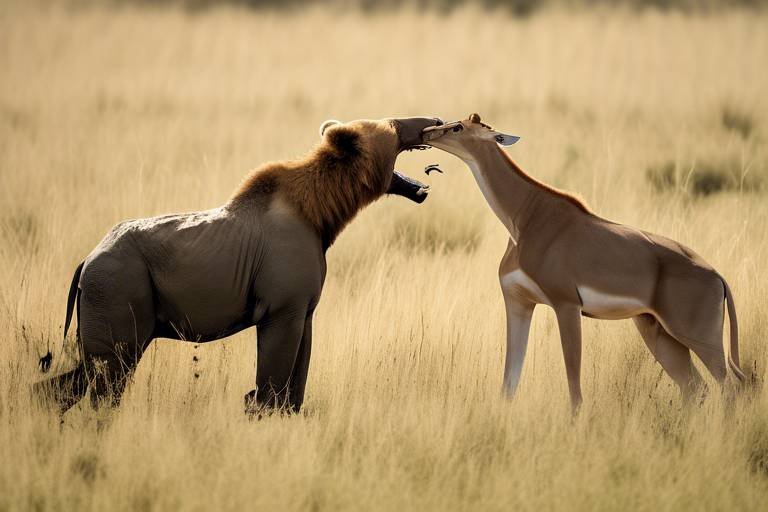Animal Farming and Biodiversity: A Complex Relationship
The relationship between animal farming and biodiversity is intricate and multifaceted, often resembling a double-edged sword. On one hand, animal farming is essential for providing food, livelihoods, and economic stability for millions around the globe. On the other hand, it poses significant threats to the natural world, leading to habitat loss, species extinction, and the disruption of ecosystems. As we dive into this complex relationship, it's crucial to understand not just the challenges but also the opportunities that exist for fostering a more sustainable approach to agriculture.
At its core, animal farming practices can lead to the degradation of habitats. For instance, the expansion of pasture lands often results in deforestation and the conversion of wetlands into agricultural fields. This transformation can severely impact local wildlife, pushing some species to the brink of extinction. Moreover, intensive farming practices can lead to nutrient run-off, which pollutes water bodies and disrupts aquatic ecosystems. With each passing year, the consequences of these practices become more pronounced, raising urgent questions about how we can balance our agricultural needs with the imperative of conserving biodiversity.
However, it’s not all doom and gloom. There are innovative farming practices emerging that strive to harmonize the needs of agriculture with the preservation of biodiversity. By adopting sustainable farming methods, farmers can mitigate the negative impacts of animal farming. Techniques such as rotational grazing, agroforestry, and organic farming not only enhance productivity but also protect and promote biodiversity within agricultural landscapes. These methods can serve as a bridge, connecting the needs of modern agriculture with the urgent call for environmental stewardship.
As we explore this relationship further, it’s essential to recognize the role of policy in shaping our agricultural landscape. Government regulations and incentives can either hinder or promote sustainable practices. The challenge lies in crafting effective policies that encourage farmers to adopt biodiversity-friendly methods while ensuring their economic viability. The synergy between animal farming and biodiversity can be achieved through collaborative efforts that unite farmers, conservationists, and policymakers in a shared vision for a sustainable future.
In conclusion, the relationship between animal farming and biodiversity is a complex dance that requires careful consideration and action. While the challenges are significant, the opportunities for innovation and sustainable practices are abundant. By understanding and addressing these dynamics, we can work towards a future where agriculture thrives alongside a rich and diverse natural world.
- What are the main threats of animal farming to biodiversity? Animal farming can lead to habitat destruction, pollution, and overexploitation of resources, all of which threaten wildlife and ecosystems.
- How can rotational grazing benefit biodiversity? Rotational grazing helps maintain healthy pastures, promotes plant diversity, and supports wildlife habitats by preventing overgrazing.
- What role do government policies play in promoting sustainable farming? Policies can provide financial incentives and create regulatory frameworks that encourage farmers to adopt practices that benefit both agriculture and biodiversity.
- Are there any successful examples of integrating animal farming and biodiversity conservation? Yes, many farms worldwide are successfully implementing agroforestry and organic practices that enhance biodiversity while maintaining productivity.

The Impact of Animal Farming on Biodiversity
Animal farming is a double-edged sword; it provides essential food resources for a growing global population but also poses significant threats to biodiversity. The process of raising livestock often leads to habitat destruction, as vast areas of land are cleared for grazing and feed production. This not only displaces native species but also disrupts the delicate balance of local ecosystems. When we think about the lush forests and vibrant grasslands that once teemed with life, it's shocking to realize how much has been lost to agricultural expansion.
Moreover, the use of monoculture crops for animal feed diminishes plant diversity, creating an environment where only a few species thrive. This lack of diversity can make ecosystems more vulnerable to pests and diseases, leading to a cycle of dependency on chemical inputs such as pesticides and fertilizers. These chemicals can further harm non-target species, including beneficial insects and soil organisms, ultimately leading to a decline in overall biodiversity.
The consequences of these practices are alarming. According to a report by the Food and Agriculture Organization (FAO), livestock farming is responsible for approximately 70% of deforestation in the Amazon rainforest. This statistic illustrates the profound impact that animal agriculture has on our planet's biodiversity. As we destroy habitats, we also pave the way for species extinction. The International Union for Conservation of Nature (IUCN) has reported that over 1 million species are currently threatened with extinction, a crisis exacerbated by unsustainable farming practices.
In addition to direct habitat loss, animal farming can lead to ecosystem imbalance. The introduction of livestock into natural habitats can disrupt food chains and alter the dynamics of predator-prey relationships. For example, overgrazing by cattle can lead to soil erosion and desertification, which in turn affects plant communities and the wildlife that depends on them. This ripple effect can create a cascade of negative outcomes that threaten not only local wildlife but also the agricultural systems that farmers rely on for their livelihoods.
To truly understand the impact of animal farming on biodiversity, we must consider the interconnectedness of all living organisms. Healthy ecosystems provide essential services such as pollination, water purification, and climate regulation. When we compromise these systems through unsustainable practices, we jeopardize not only wildlife but also our own future. The challenge lies in finding a balance between the demands of food production and the need to protect our planet’s rich biodiversity.
| Impact of Animal Farming | Consequences |
|---|---|
| Habitat Destruction | Loss of species, ecosystem disruption |
| Monoculture Feed Production | Diminished plant diversity, increased vulnerability |
| Chemical Inputs | Harm to beneficial species, soil degradation |
| Overgrazing | Soil erosion, desertification |
In conclusion, the impact of animal farming on biodiversity is profound and multifaceted. As we strive for a sustainable future, it is imperative to recognize the intricate relationship between our agricultural practices and the health of our ecosystems. By adopting more sustainable methods, we can protect biodiversity while still meeting the food needs of our growing population. The road ahead may be challenging, but with concerted efforts, we can create a balance that benefits both agriculture and the natural world.

Sustainable Farming Practices
Sustainable farming practices are more than just a trend; they represent a fundamental shift in how we think about agriculture and its impact on the environment. As the world grapples with the consequences of climate change and biodiversity loss, these practices emerge as beacons of hope. They aim to minimize environmental impact while maintaining productivity, ensuring that we can feed a growing population without depleting our natural resources. Imagine a world where farms not only produce food but also enhance the ecosystems around them. Sounds ideal, right? Well, it's possible through various methods that can help protect biodiversity in agricultural landscapes.
One of the most effective sustainable farming methods is rotational grazing. This technique involves moving livestock between different pastures, allowing grazed areas to recover and regenerate. By preventing overgrazing, rotational grazing not only enhances soil health but also promotes plant diversity and supports wildlife habitats. Think of it as giving nature a chance to breathe and rejuvenate. When livestock are rotated, the pastures have time to recover, leading to a more balanced ecosystem that benefits both the animals and the surrounding wildlife.
Another promising approach is agroforestry, which integrates trees and shrubs into agricultural landscapes. This practice is like creating a mini-ecosystem within a farm. Trees provide shade, improve soil fertility, and offer habitats for various species. They also play a crucial role in increasing resilience against climate change, acting as natural buffers against extreme weather events. The benefits of agroforestry are manifold, as it not only enhances biodiversity but also contributes to the overall health of the agricultural system.
In addition to these methods, organic farming remains a cornerstone of sustainable agriculture. By avoiding synthetic fertilizers and pesticides, organic farming promotes healthier soils and ecosystems. Farmers who adopt organic practices often find that their crops are more resilient to pests and diseases, leading to increased yields over time. It's a win-win situation: healthier food for consumers and a healthier planet.
However, as with any approach, there are challenges to implementing sustainable farming practices. For instance, initial setup costs can be a barrier for many farmers. Transitioning to methods like rotational grazing or agroforestry often requires investment in infrastructure and training. Additionally, farmers must be willing to adapt their practices and learn new techniques, which can be daunting. But the long-term benefits—improved pasture quality, increased forage availability, and enhanced carbon sequestration—can far outweigh these initial hurdles. It's essential for farmers to weigh these factors carefully and consider the potential for a sustainable future.
In conclusion, sustainable farming practices are not just beneficial; they are necessary for the health of our planet. By embracing methods like rotational grazing, agroforestry, and organic farming, we can create agricultural systems that support biodiversity and contribute to a healthier environment. The journey may be challenging, but the rewards—both for farmers and the planet—are truly worth it.

Rotational Grazing Techniques
Rotational grazing is a fascinating method that involves the strategic movement of livestock between different pastures. Imagine a dance between the animals and the land, where each step is carefully planned to ensure the health of both. This technique not only prevents overgrazing but also enhances soil health, promotes plant diversity, and supports vital wildlife habitats. By allowing pastures to rest and regenerate, rotational grazing creates a more balanced ecosystem, akin to a well-tuned orchestra where each instrument plays its part harmoniously.
One of the key aspects of rotational grazing is its ability to improve the quality of pastures. When livestock are rotated, they graze on fresh grass, which encourages the growth of a variety of plants. This diversity is crucial for maintaining a healthy ecosystem, as it supports different species of insects, birds, and other wildlife. Furthermore, healthy pastures contribute to better soil structure and fertility, which in turn leads to increased forage availability. Think of it as nurturing a garden where each plant contributes to the overall beauty and productivity of the space.
Another significant benefit of rotational grazing is its role in carbon sequestration. By promoting healthy grasslands, this technique can help capture carbon dioxide from the atmosphere, mitigating the effects of climate change. Essentially, the grasses act like sponges, absorbing carbon and storing it in the soil. This process not only benefits the environment but also enhances the resilience of the farming system against climate variability.
However, implementing rotational grazing is not without its challenges. Farmers must consider the need for adequate land management and the initial setup costs associated with creating multiple pastures. This can include fencing, water supply systems, and planning for livestock movement. While these factors can be daunting, the long-term benefits often outweigh the initial hurdles. By investing in rotational grazing, farmers can enjoy improved pasture quality and healthier livestock, leading to greater productivity and sustainability.
To further illustrate the benefits and challenges of rotational grazing, here’s a quick comparison:
| Benefits | Challenges |
|---|---|
| Improved pasture quality | Need for adequate land management |
| Increased forage availability | Initial setup costs |
| Enhanced carbon sequestration | Requires careful planning and monitoring |
| Supports wildlife habitats | Potential for increased labor |
In conclusion, rotational grazing techniques offer a promising avenue for sustainable animal farming. By fostering a symbiotic relationship between livestock and the land, farmers can contribute to biodiversity conservation while enhancing their productivity. It's a win-win situation that not only benefits the farmers but also the environment. So, if you're a farmer or just someone interested in sustainable practices, consider the dance of rotational grazing—it might just be the rhythm your land needs!
- What is rotational grazing? Rotational grazing is a method of managing livestock by moving them between pastures to prevent overgrazing and promote ecosystem health.
- How does rotational grazing benefit the environment? It improves soil health, increases plant diversity, supports wildlife habitats, and enhances carbon sequestration.
- What are the challenges of implementing rotational grazing? Some challenges include the need for adequate land management, initial setup costs, and careful planning.
- Can rotational grazing improve livestock health? Yes, healthier pastures lead to better forage quality, which can improve livestock health and productivity.

Benefits of Rotational Grazing
Rotational grazing is not just a farming technique; it’s a transformative approach that can significantly enhance both the health of the land and the well-being of livestock. By moving animals between different pastures, farmers can prevent overgrazing, which is akin to giving the land a much-needed breather. This practice allows grasses and other plants to recover, leading to a richer and more diverse plant community. Imagine a vibrant tapestry of greens and browns where various species of plants thrive, creating a habitat that supports a plethora of wildlife.
One of the most profound benefits of rotational grazing is its positive impact on soil health. When livestock are rotated, manure is evenly distributed across the land, enriching the soil with essential nutrients. This natural fertilization process not only boosts soil fertility but also enhances its structure, leading to better water retention and reduced erosion. Healthy soil is the backbone of any sustainable farming system, and rotational grazing plays a pivotal role in maintaining it.
Moreover, this method can significantly increase carbon sequestration. As the plants grow back, they absorb carbon dioxide from the atmosphere, helping to mitigate climate change. It's like planting a tree, but on a larger scale, where every blade of grass contributes to a healthier planet. According to studies, rotational grazing can increase carbon storage in the soil by up to 1.5 tons per hectare annually, a figure that should make any environmentally-conscious farmer sit up and take notice.
Additionally, rotational grazing fosters greater biodiversity within agricultural landscapes. By allowing different plant species to flourish, it creates a more resilient ecosystem that can better withstand pests and diseases. This biodiversity is crucial, as it supports a range of wildlife, from insects to birds, which in turn helps in pollination and pest control. In a sense, rotational grazing acts like a symphony, where each element plays its part to create a harmonious environment.
In summary, the benefits of rotational grazing extend far beyond the immediate advantages for livestock. It leads to:
- Improved pasture quality: Healthier plants lead to better forage for livestock.
- Increased forage availability: With plants recovering more effectively, there’s always plenty of food for the animals.
- Enhanced carbon sequestration: A significant reduction in greenhouse gases.
- Boosted biodiversity: A richer ecosystem that supports various species.
Ultimately, rotational grazing is a win-win situation, providing benefits to farmers, livestock, and the environment alike. It’s a clear demonstration of how thoughtful agricultural practices can lead to a more sustainable future.
Q1: What is rotational grazing?
Rotational grazing is a method where livestock are moved between different pastures to prevent overgrazing and promote healthier plant growth.
Q2: How does rotational grazing improve soil health?
By evenly distributing manure and allowing plants to recover, rotational grazing enriches the soil with nutrients and improves its structure.
Q3: Can rotational grazing help with climate change?
Yes, it can increase carbon sequestration in the soil, helping to mitigate the effects of climate change.
Q4: What are the economic benefits of rotational grazing?
While there may be initial setup costs, the long-term benefits include improved pasture quality and reduced feed costs, leading to greater profitability.

Challenges of Rotational Grazing
While rotational grazing offers numerous benefits for both livestock and the environment, it is not without its challenges. One of the primary hurdles is the need for adequate land management. Farmers must carefully plan and monitor grazing patterns to ensure that pastures are not overgrazed or underutilized. This requires a keen understanding of the land, the animals, and how they interact with each other. Without proper management, the very benefits that rotational grazing aims to achieve can quickly evaporate.
Another challenge is the initial setup costs. Transitioning to a rotational grazing system often requires investment in infrastructure, such as fencing and water supply systems. Farmers may need to purchase additional equipment or modify existing facilities to accommodate the movement of livestock. This upfront financial burden can be a significant barrier, especially for smaller farms or those already facing economic pressures.
Moreover, the climate plays a crucial role in the success of rotational grazing. In regions where weather patterns are unpredictable, it can be difficult to establish a consistent grazing schedule. For instance, prolonged droughts can reduce pasture growth, making it challenging to rotate livestock effectively. Conversely, excessive rainfall can lead to muddy conditions that are detrimental to both animals and soil health. Farmers must remain adaptable and responsive to these environmental changes, which can add another layer of complexity to their operations.
Additionally, there is the knowledge gap that exists within the farming community. Not all farmers are familiar with the principles and practices of rotational grazing, which can lead to inconsistent application and mixed results. Education and training are essential to ensure that farmers understand how to implement this system effectively. Workshops, online resources, and peer-to-peer learning can help bridge this gap, but they require time and commitment from the farming community.
Lastly, farmers must consider the social dynamics of their communities. Implementing rotational grazing can sometimes lead to conflicts over land use, especially in areas where land is scarce or highly contested. Farmers may need to engage in discussions with neighbors and local authorities to find solutions that work for everyone, which can be a time-consuming process. Building strong relationships and fostering open communication is essential for navigating these challenges.
In summary, while rotational grazing presents a promising path toward sustainable agriculture, it is not a silver bullet. Farmers must carefully weigh the challenges of land management, initial costs, climate variability, knowledge gaps, and social dynamics against the potential benefits. With the right support and resources, however, many can successfully adopt this method and contribute to a healthier ecosystem.
- What is rotational grazing? Rotational grazing is a livestock management practice where animals are moved between different pastures to prevent overgrazing and promote soil health.
- What are the benefits of rotational grazing? Benefits include improved pasture quality, enhanced biodiversity, and better soil health, which collectively contribute to a more sustainable farming system.
- What challenges do farmers face with rotational grazing? Challenges include the need for adequate land management, initial setup costs, climate variability, knowledge gaps, and social dynamics within communities.

Agroforestry Systems
Agroforestry systems represent a revolutionary approach to agriculture that intertwines trees and shrubs with traditional farming practices. Imagine walking through a vibrant landscape where crops flourish alongside towering trees, creating a symphony of life that not only nourishes the soil but also supports a myriad of wildlife. This integration of forestry and agriculture is not just a fanciful idea; it is a practical method that enhances biodiversity while simultaneously improving the productivity of farmland. By incorporating trees into agricultural landscapes, farmers can create a more resilient ecosystem that withstands the pressures of climate change and environmental degradation.
One of the most significant benefits of agroforestry is its ability to improve soil fertility. Trees contribute to nutrient cycling by shedding leaves that decompose and enrich the soil. This natural process reduces the need for chemical fertilizers, which can be detrimental to both the environment and human health. Additionally, the shade provided by trees can help to regulate soil temperature and moisture levels, creating a more stable environment for crops to thrive.
Furthermore, agroforestry systems offer habitats for various species, promoting wildlife conservation. These systems can serve as corridors for animals, allowing them to move freely between different habitats. For instance, birds, insects, and small mammals find refuge in the understory of trees, which can significantly enhance local biodiversity. In a world where species extinction is a pressing concern, agroforestry presents a viable solution to protect and promote wildlife.
In terms of economic viability, agroforestry can also prove beneficial for farmers. By diversifying their income sources, farmers can reduce their reliance on a single crop, which can be risky due to market fluctuations and climate variability. For example, a farmer might grow coffee under the shade of cacao trees, allowing them to harvest two products simultaneously. This not only maximizes land use but also provides a buffer against potential crop failures.
However, implementing agroforestry systems is not without its challenges. Farmers need to invest time and resources into planning and establishing these systems. It requires a shift in mindset from traditional monoculture farming to a more holistic approach. Training and education are essential to equip farmers with the knowledge they need to manage these complex systems effectively. Moreover, the initial setup costs can be a barrier for many, but the long-term benefits often outweigh these challenges.
In summary, agroforestry systems present a promising path toward sustainable agriculture. By integrating trees into farming practices, we can foster biodiversity, enhance ecosystem services, and improve the resilience of our agricultural landscapes. As we face the dual challenges of food security and environmental conservation, agroforestry stands out as a beacon of hope, reminding us that nature and agriculture can coexist harmoniously.
- What is agroforestry? Agroforestry is an agricultural practice that integrates trees and shrubs with crops and/or livestock to create a more sustainable and productive farming system.
- How does agroforestry benefit biodiversity? By providing habitats for various species and enhancing soil health, agroforestry promotes a diverse range of flora and fauna, contributing to overall ecosystem health.
- Are there economic benefits to agroforestry? Yes, agroforestry can diversify income sources for farmers, reduce reliance on single crops, and ultimately lead to more stable farm incomes.
- What challenges do farmers face when implementing agroforestry? Challenges include the need for proper planning, initial setup costs, and a shift in traditional farming practices. Education and training are crucial for successful implementation.

The Role of Policy in Biodiversity Conservation
Government policies are the backbone of effective biodiversity conservation, especially in the context of animal farming. These policies shape how farmers operate, influencing their decisions on land use, animal husbandry, and sustainable practices. Without a robust policy framework, efforts to protect biodiversity can often fall short, leading to detrimental impacts on ecosystems. A well-designed policy can serve as a guiding light, encouraging practices that not only sustain agricultural productivity but also promote the health of our planet's diverse species.
One of the key roles of policy is to create incentives for sustainable practices. Financial support, such as subsidies or grants, can motivate farmers to adopt environmentally friendly methods. For instance, farmers who implement rotational grazing or agroforestry systems may receive monetary benefits that help offset their initial investment costs. This approach not only encourages biodiversity-friendly practices but also fosters a culture of environmental stewardship within the agricultural community. By aligning economic benefits with sustainable farming methods, policies can effectively encourage farmers to prioritize biodiversity conservation.
Moreover, the development of regulatory frameworks is essential in promoting biodiversity conservation. Regulations can set standards for land use, water management, and animal welfare, ensuring that farming practices do not come at the expense of ecosystems. For example, regulations that limit deforestation for pastureland can help preserve critical habitats for various species. Additionally, policies that promote the use of native plants in animal feed can enhance local biodiversity. However, these frameworks must be carefully crafted to avoid placing undue burdens on farmers, which could lead to resistance against compliance.
In many regions, policies are evolving to address the complex relationship between agriculture and biodiversity. Governments are beginning to recognize that protecting biodiversity is not just an environmental issue; it's also crucial for agricultural sustainability and food security. For instance, policies that support the conservation of pollinators, such as bees, are vital for maintaining crop yields. By integrating biodiversity goals into agricultural policy, governments can create a more sustainable future for both farmers and wildlife.
To illustrate the impact of policy on biodiversity conservation, consider the following table that outlines various incentives and regulations aimed at promoting sustainable animal farming practices:
| Type of Policy | Description | Examples |
|---|---|---|
| Financial Incentives | Monetary support for adopting sustainable practices | Subsidies for organic farming, grants for agroforestry |
| Regulatory Standards | Rules that govern land use and animal welfare | Limits on deforestation, animal welfare regulations |
| Conservation Programs | Initiatives aimed at preserving ecosystems | Pollinator protection plans, habitat restoration projects |
In conclusion, the role of policy in biodiversity conservation cannot be overstated. It serves as a powerful tool to influence agricultural practices, ensuring they align with conservation goals. By providing incentives and establishing regulatory frameworks, governments can foster a sustainable agricultural landscape that benefits both farmers and the environment. As we move forward, it is essential for policymakers to engage with farmers, conservationists, and scientists to create policies that are effective, equitable, and adaptable to the changing needs of our ecosystems.
- What are the main goals of biodiversity conservation policies? The primary goals include protecting endangered species, preserving habitats, and promoting sustainable agricultural practices.
- How can farmers benefit from sustainable practices? Sustainable practices can lead to healthier ecosystems, improved soil quality, and potentially higher yields, along with financial incentives from government programs.
- What challenges do policymakers face in promoting biodiversity? Policymakers often contend with balancing agricultural productivity with environmental protection, as well as addressing the economic concerns of farmers.

Incentives for Sustainable Practices
Incentives for sustainable practices in animal farming are not just a nice-to-have; they are essential for creating a more environmentally friendly agricultural landscape. Imagine a world where farmers are rewarded for their efforts to protect biodiversity, rather than solely focusing on maximizing output. This shift in perspective can lead to a healthier planet and a more sustainable food system. Financial incentives, such as grants, tax breaks, and subsidies, can encourage farmers to adopt practices that benefit both their operations and the environment.
For instance, government programs that provide direct payments to farmers who implement sustainable practices can significantly reduce the financial burden associated with these changes. By offsetting initial costs, farmers may be more inclined to invest in techniques like rotational grazing or organic farming. Additionally, these programs can help in building a community of farmers who are committed to environmental stewardship, creating a ripple effect that encourages others to follow suit.
Furthermore, the integration of education and training into these incentive programs is crucial. Farmers need access to resources that equip them with the knowledge and skills necessary to implement sustainable practices effectively. Workshops, online courses, and mentorship programs can be invaluable in this regard. When farmers understand the long-term benefits of sustainability—not just for the environment, but also for their bottom line—they are more likely to embrace these practices.
In addition to direct financial support, market incentives can also play a pivotal role. Consumers are increasingly aware of the environmental impact of their food choices, and many are willing to pay a premium for products that are sustainably sourced. By creating a market for sustainably farmed animal products, governments can encourage farmers to adopt practices that protect biodiversity. This creates a win-win situation: consumers get healthier, ethically produced food, and farmers enjoy better prices for their products.
To sum up, the transition to sustainable animal farming hinges on the right incentives. By providing financial support, education, and creating market opportunities, we can empower farmers to make choices that benefit both their livelihoods and the planet. The journey toward sustainability is not just about preserving biodiversity; it’s about fostering a new agricultural paradigm that prioritizes ecological health and economic viability.
- What are sustainable farming practices? Sustainable farming practices are methods that aim to produce food in a way that is environmentally friendly, socially responsible, and economically viable. They include techniques like organic farming, agroforestry, and rotational grazing.
- How do incentives for sustainable practices work? Incentives can include financial support such as subsidies, grants, and tax breaks, as well as educational resources and market opportunities that encourage farmers to adopt environmentally friendly practices.
- Why is biodiversity important in farming? Biodiversity is crucial for maintaining healthy ecosystems, which in turn supports food production, pest control, and soil health. A diverse agricultural landscape can also enhance resilience against climate change.
- Can consumers influence sustainable farming? Absolutely! By choosing to purchase sustainably sourced products, consumers can drive demand for environmentally friendly farming practices, encouraging more farmers to adopt these methods.

Regulatory Frameworks
The relationship between animal farming and biodiversity is complex, and effective are essential for ensuring that agricultural practices do not come at the expense of our planet's diverse ecosystems. Governments around the world have a critical role to play in shaping policies that not only support farmers but also protect the environment. These frameworks can include a variety of strategies, such as land-use regulations, conservation easements, and incentives for sustainable practices.
One of the primary goals of regulatory frameworks is to create a balance between agricultural productivity and biodiversity conservation. For instance, regulations can mandate that a certain percentage of farmland is set aside for wildlife habitats, which can help mitigate the negative impacts of farming on local ecosystems. Additionally, policies can promote practices that enhance biodiversity, such as organic farming or integrated pest management, which reduces reliance on harmful chemicals.
Moreover, financial incentives can be a game-changer in encouraging farmers to adopt more sustainable practices. These incentives can come in various forms, including grants, tax breaks, or subsidies for those who implement biodiversity-friendly techniques. By alleviating some of the financial burdens associated with transitioning to sustainable methods, farmers may be more inclined to adopt practices that benefit both their operations and the environment.
However, it’s not just about providing incentives; there also needs to be a robust system of regulations that holds farmers accountable for their environmental impact. This can include monitoring and reporting requirements that ensure compliance with biodiversity conservation goals. The effectiveness of these regulations often hinges on collaboration between government agencies, non-profit organizations, and the farming community. When these stakeholders work together, they can create a regulatory environment that fosters innovation while safeguarding biodiversity.
In many regions, existing policies may need to be revisited and revised to better align with current environmental challenges. For example, as climate change continues to alter ecosystems, regulatory frameworks must adapt to ensure they remain effective. This may involve implementing more stringent guidelines for land use or enhancing protections for endangered species that are affected by farming practices.
In conclusion, the role of regulatory frameworks in promoting biodiversity conservation within animal farming cannot be overstated. By implementing thoughtful regulations and providing incentives for sustainable practices, we can create an agricultural system that not only feeds the world but also protects the rich tapestry of life that exists on our planet. The challenge lies in crafting policies that are both effective and fair, ensuring that farmers can thrive while also being stewards of the land.
- What are regulatory frameworks? Regulatory frameworks are systems of rules and guidelines established by governments to manage various sectors, including agriculture, to promote sustainability and protect the environment.
- How do regulatory frameworks impact animal farming? They can either promote or restrict certain farming practices based on their environmental impact, helping to balance agricultural productivity with biodiversity conservation.
- What role do financial incentives play? Financial incentives encourage farmers to adopt sustainable practices by offsetting costs associated with transitioning to methods that are better for the environment.
- Why is collaboration important? Collaboration among government, non-profits, and farmers ensures that policies are practical, effective, and beneficial to all parties involved.
Frequently Asked Questions
- How does animal farming impact biodiversity?
Animal farming can lead to significant biodiversity loss due to habitat destruction, overgrazing, and pollution. The conversion of natural habitats into farmland often results in the extinction of various species and disrupts local ecosystems.
- What are sustainable farming practices?
Sustainable farming practices are methods that aim to reduce environmental impact while maintaining agricultural productivity. Examples include rotational grazing, agroforestry, and organic farming, all of which help protect biodiversity and promote healthier ecosystems.
- What is rotational grazing and why is it beneficial?
Rotational grazing is a practice where livestock are moved between different pastures to prevent overgrazing. This technique enhances soil health, promotes plant diversity, and supports wildlife habitats, leading to a more balanced ecosystem.
- What challenges do farmers face with rotational grazing?
While rotational grazing has many benefits, farmers may encounter challenges such as the need for effective land management and the initial setup costs. It's essential for farmers to evaluate these factors against the long-term advantages of this practice.
- How does agroforestry contribute to biodiversity?
Agroforestry integrates trees and shrubs into agricultural systems, which promotes biodiversity by creating habitats for various species. This method also enhances soil fertility and resilience against climate change, benefiting both crops and wildlife.
- What role do government policies play in biodiversity conservation?
Government policies are vital in shaping agricultural practices that can either harm or help biodiversity. Regulations and incentives can encourage farmers to adopt sustainable practices that align with conservation goals, ensuring a balance between farming and wildlife preservation.
- What types of incentives exist for sustainable farming?
Financial incentives such as subsidies and grants are available for farmers who implement sustainable practices. These programs can help offset costs and encourage environmentally friendly farming, fostering a culture of stewardship in agriculture.
- What are some effective regulatory frameworks for promoting biodiversity?
Effective regulatory frameworks include policies that set conservation goals, provide guidelines for sustainable farming, and enforce compliance. Continuous improvement of these policies is essential to better align agricultural practices with the needs of biodiversity conservation.



















